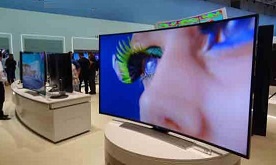Soon, a new technology called Next Gen TV will be launched on the market, which supports the display of 4K images and high bandwidth.

According to Zomit, we will probably soon see more news about the new TV broadcasting technology called Next Gen TV; Technology that promises better image quality, greater signal resistance to interference, interactive features, and emergency alerts.
In fact, Next Gen TVs are an evolved model of the ATSC air-based broadcasting technology that is used in North America and the developers decide to expand it. In the following, we intend to provide complete and comprehensive explanations of this technology and answer your frequently asked questions in this field.
What is ATSC 3.0 and where is the difference?
In fact, the new broadcast technology standard is an updated version of the current broadcast technology standard; This means that the ATSC 1.0 standard has been updated with a set of new features and technologies. This technology is based on IP or Internet Protocol and its purpose is to integrate TV with Internet content.
In this technology, more modern compression systems are used to support high bandwidth; This feature enables broadcasters to send 4K UHD signals or high-quality channels in the same space.
Developers have promised to send better signals to transmitters, which could be good news for the betterment of apartment wiring. They also plan to provide a wide range of new services for TV viewers. Of course, similar promises were made before, but apparently, consumers did not show much desire for it.
One of the main reasons why broadcasters are so enthusiastic about Next Gen TV is the possibility of more advertising.
By using this technology, instead of ads being displayed only in a certain area of service, the viewers of certain cities and neighbors of that point will also be able to watch them.
What will be the state of privacy in ATSC 3.0?
This is a question that the FCC decided not to address before the launch of Next Gen TV. The specifications of this TV, the details of the data recorded and collected by the developers, how they use it, or how they protect it have not been leaked yet.
The release of this TV may mean the end of internet advertising, but it is even more annoying than that. Also, do you tend to see ads for products you’ve already purchased?
When will Next Gen TV be available?
The first devices will be available in Arizona and Phoenix in the first half of 2018. Broadcasters have chosen these cities as a test market to determine feedback and how the technology will be used.
Currently, the FCC does not provide broadcasters with space for ATSC 3.0 broadcasting and guidelines for the persistence of ATSC 1.0 signals over the next five years; Therefore, the broadcasters themselves have to do the sharing of the transmitter, the specifications of which are not yet available.
The widespread provision of the above technology depends on the acceptance of consumers. Consumer acceptance also depends on factors such as the price of the equipment, the availability of programs in 4K resolution, or the type of interactivity that was promised.
South Korea adopted ATSC 3.0 technology in mid-2017, But the number of 4K programs was still very few. Hence, it took some time to complete this process.
Will we need a new TV or antenna to launch this technology?
Next Gen TV will be broadcast on existing television frequencies; So you won’t need a new antenna. But since the format of this technology is completely new, you will probably need a new TV or converter.
Currently, there is no TV or converter available in the market. Of course, it is too early to talk about the price of this technology; But we are sure about one thing, and that is that the government will not pay a subsidy for the converter box, unlike the analog-to-digital converter device.
Considering that the previous technology has been in use for five years, it can be assumed that users have not lost access to the main networks; Although the transmission of data to the transmitter may result in the attenuation of some low frequencies.
But the total functions of this technology still need more decisions and its presentation should be implemented city by city. One of the advantages of this technology is that it does not need TV stations to transmit the signal in the air.
If Next Gen TV is not available, viewers without new TVs or set-top boxes can watch low-definition but high-bandwidth channels made available by ATSC 3.0 signals.
